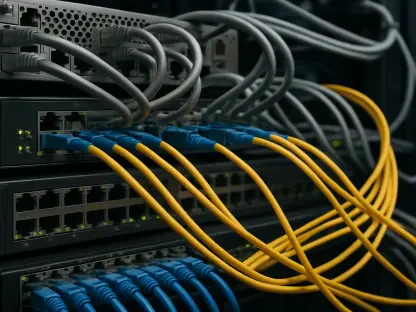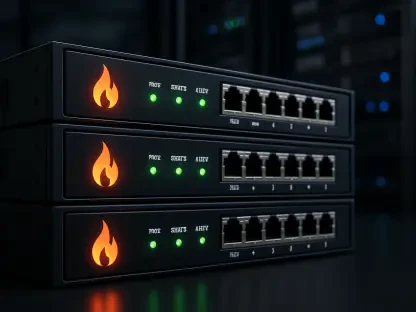In an era where technology is advancing at an unprecedented pace, artificial intelligence (AI) is undergoing a profound transformation that could redefine how society interacts with data and decision-making. This shift, driven by Edge AI, moves away from traditional centralized cloud systems to a decentralized model where intelligence is processed right at the source—be it a smartphone, an IoT sensor, or a vehicle. This change is not merely a technical adjustment but a complete reimagining of how AI operates, addressing critical issues like latency, privacy breaches, and bandwidth overload that have long hindered cloud-centric approaches. Imagine a scenario where an autonomous car navigates a busy intersection, making split-second decisions without relying on a distant server, or a wearable device instantly flags a health anomaly without transmitting sensitive data. Edge AI is making such possibilities a reality, embedding computational power into the very devices that generate data. This revolution is already reshaping industries, from healthcare to urban planning, by enabling real-time responsiveness and heightened security. Yet, as this technology proliferates, it brings with it a host of challenges that must be navigated carefully. This exploration delves into the mechanisms, impacts, and future potential of Edge AI, uncovering why this shift toward decentralized intelligence is a game-changer for the modern world.
Understanding Edge AI and Decentralized Intelligence
The Shift from Centralized to Edge Computing
Edge AI marks a significant departure from the conventional model of centralized cloud computing, where data must travel to remote servers for processing, often introducing delays and security risks. By contrast, Edge AI empowers devices to handle data locally, right where it is generated, whether on a factory floor sensor or a consumer gadget. This localized processing slashes latency, enabling near-instantaneous responses that are critical for time-sensitive applications. For instance, in autonomous vehicles, decisions about braking or swerving cannot afford the milliseconds of delay that cloud communication might introduce. Additionally, keeping data on-device reduces exposure to external networks, bolstering security in an age where cyber threats loom large. This paradigm shift is not just about speed but about fundamentally rethinking how AI can function in environments where connectivity may be unreliable or nonexistent, such as remote industrial sites or rural areas. The implications of this transition are vast, promising to make AI more accessible and practical across diverse settings, while also challenging traditional infrastructure models that have dominated for decades.
Beyond the technical advantages, the move to Edge AI reflects a growing demand for efficiency in an increasingly connected world, where billions of devices are now linked through the Internet of Things (IoT). The sheer volume of data being produced is staggering, often overwhelming centralized systems. Edge AI alleviates this burden by distributing computational tasks, ensuring that only essential data, if any, is sent to the cloud for further analysis. This not only conserves bandwidth but also cuts down on energy consumption associated with long-distance data transfers. Moreover, it enables systems to continue functioning during network outages, a resilience that is invaluable for mission-critical applications like emergency response systems or disaster management tools. As industries grapple with the dual needs of scalability and reliability, Edge AI emerges as a solution that aligns with the realities of modern data demands, setting the stage for a more robust and adaptable technological landscape.
Why Decentralization Matters
The importance of decentralized intelligence through Edge AI lies in its ability to address some of the most pressing limitations of cloud-centric models, particularly around privacy and connectivity. By processing data locally, Edge AI minimizes the need to transmit sensitive information to distant servers, significantly reducing the risk of interception or unauthorized access. This is especially crucial in sectors like healthcare, where patient data confidentiality is paramount, or in financial services, where transaction security is non-negotiable. Furthermore, local processing ensures that personal information remains on the user’s device, aligning with stringent data protection regulations that are becoming increasingly common globally. This privacy-first approach is not just a compliance measure but a trust-building mechanism, reassuring users that their data is handled with the utmost care in an era of frequent breaches.
Equally significant is the resilience that decentralization brings to systems operating in challenging environments. In remote locations or areas with inconsistent internet access, reliance on cloud infrastructure can render AI applications ineffective or entirely unusable, but Edge AI overcomes this barrier by enabling devices to function autonomously. This ensures continuous operation regardless of network status. This capability is transformative for industries like agriculture, where sensors on farming equipment can analyze soil conditions in real-time without connectivity, or for military applications where secure, independent operation is critical. By reducing dependency on centralized infrastructure, Edge AI fosters a level of operational independence that is essential for expanding AI’s reach into underserved or unstable regions, thereby democratizing access to advanced technology and its benefits.
Technical Innovations Powering Edge AI
Hybrid Architectures and Privacy-Preserving Techniques
At the heart of Edge AI’s rise are hybrid architectures that intelligently distribute computational workloads between edge devices and cloud systems, optimizing for both speed and resource use. These architectures allow low-latency tasks, such as real-time image recognition on a security camera, to be processed locally, while more intensive computations, like model training, can still leverage the cloud’s power. This balance ensures efficiency without sacrificing capability, making Edge AI viable for a wide range of applications. A key component of this innovation is Federated Learning, a technique that enables collaborative AI model training across multiple devices without ever sharing raw data. Instead, only model updates are exchanged, preserving user privacy while still benefiting from collective intelligence. This method is particularly impactful in scenarios where data sensitivity is high, allowing organizations to improve AI systems without compromising confidentiality.
Complementing these architectures are advancements in secure aggregation protocols that further enhance the privacy-preserving nature of Edge AI. These protocols ensure that even the shared model updates in Federated Learning are encrypted, preventing any potential exposure during transmission. Such techniques are vital for industries that must adhere to strict regulatory frameworks, ensuring compliance while still harnessing the power of distributed intelligence. Additionally, hybrid systems are evolving to dynamically adapt to network conditions, shifting workloads based on real-time connectivity and device capacity. This adaptability is crucial for maintaining performance in fluctuating environments, such as mobile devices moving between strong and weak signal areas. As these technologies mature, they are setting a new standard for how AI can be deployed securely and efficiently, paving the way for broader adoption across sectors that prioritize both innovation and data protection.
Hardware Advancements for Resource-Constrained Devices
Edge AI’s ability to operate on resource-constrained devices owes much to groundbreaking hardware innovations tailored for low-power environments. Specialized AI chips, such as Neural Processing Units (NPUs) and Edge Tensor Processing Units (TPUs), are designed to execute complex algorithms with minimal energy consumption, a stark contrast to traditional processors that often drain batteries quickly. These chips, paired with frameworks like TinyML, allow sophisticated AI models to run on everything from wearable fitness trackers to industrial sensors, embedding intelligence into the smallest of devices. By compressing models and optimizing computations, these technologies achieve a remarkable reduction in power usage—often by 50-70% compared to older systems—making AI sustainable for long-term deployment in battery-powered equipment.
Looking further, the horizon of hardware innovation includes neuromorphic computing, which mimics the human brain’s neural structures to perform AI tasks with unparalleled efficiency, promising to revolutionize technology. Though still in its early stages, this technology aims to transform edge devices by enabling ultra-low-power inference, potentially changing how AI integrates into everyday objects. Meanwhile, current advancements in model quantization and pruning techniques ensure that even existing hardware can handle AI workloads more effectively, extending the lifespan of deployed devices. This focus on efficiency is critical as the number of connected devices continues to skyrocket, ensuring that Edge AI can scale without imposing unsustainable energy demands. These hardware breakthroughs are not just technical feats but enablers of a future where intelligence is seamlessly woven into the fabric of daily life, accessible even in the most constrained settings.
Industry Impacts and Societal Integration
Transformative Applications Across Sectors
Edge AI is already making waves across diverse industries by facilitating real-time, localized decision-making that was previously unattainable, marking a significant shift in how data is processed and utilized. In healthcare, wearable devices equipped with edge processing can detect critical conditions like irregular heartbeats instantly, alerting users or medical professionals without the delay of cloud transmission. This immediacy can be life-saving, particularly for patients in remote areas with limited access to hospitals. Similarly, in manufacturing, Edge AI powers predictive maintenance by analyzing sensor data directly on factory equipment, identifying potential failures before they occur and minimizing costly downtime. Such applications highlight how localized intelligence transforms operational efficiency, reducing reliance on distant data centers and enabling swift, actionable insights at the point of need.
In the realm of urban planning, Edge AI is proving instrumental in building smarter cities through dynamic systems that adapt to real-time conditions, revolutionizing how urban environments function. Traffic management solutions, for instance, use edge-processed data from cameras and sensors to adjust signal timings on the fly, easing congestion without requiring constant cloud connectivity. Environmental monitoring systems also benefit, with localized AI analyzing air quality or noise levels to inform public safety measures instantly. These examples underscore a broader trend: Edge AI is embedding intelligence directly into the physical world, creating infrastructure that responds to human needs with unprecedented speed. As more sectors adopt this technology, the potential for tailored, immediate solutions grows, fundamentally altering how communities and industries address complex challenges in real time.
Competitive Dynamics and Ecosystem Growth
The competitive landscape surrounding Edge AI is as dynamic as the technology itself, with major tech players and emerging innovators vying for influence. Tech giants like Microsoft and Google are capitalizing on their extensive cloud infrastructure to develop seamless edge-cloud orchestration platforms, simplifying the deployment of distributed AI for businesses of all sizes. These comprehensive ecosystems provide tools that integrate edge processing with existing systems, giving established companies a significant edge in market reach. Meanwhile, hardware leaders like NVIDIA are driving innovation in AI-specific chips, ensuring that devices at the edge have the computational power needed for complex tasks. This synergy between software and hardware giants is accelerating the adoption of Edge AI, creating robust solutions that cater to diverse industry needs.
At the same time, startups and open-source communities are playing a pivotal role in shaping this space by focusing on niche areas like lightweight AI models and specialized accelerators. These smaller entities often challenge the status quo, introducing disruptive ideas that prioritize accessibility and sustainability. The rise of collaborative frameworks, such as those supporting Federated Learning, further fosters an ecosystem where innovation is not monopolized but shared across organizations. This democratization trend suggests a future where AI development is not confined to a handful of corporations but is instead a collective effort, driven by diverse contributors. As competition and collaboration coexist, the Edge AI ecosystem is evolving into a vibrant network that promises to make advanced technology more inclusive, potentially transforming how intelligence is developed and deployed globally.
Challenges in Deploying Edge AI
Security and Management Complexities
As Edge AI proliferates across countless devices, it inadvertently expands the attack surface for potential cyber threats, posing significant security challenges that cannot be ignored in today’s interconnected world. Unlike centralized systems where updates and patches can be managed uniformly, edge devices often operate in disparate, unmonitored environments, making them vulnerable to exploits if robust update mechanisms are absent. A compromised device, such as a smart home sensor, could serve as an entry point for broader network breaches, jeopardizing entire systems. This risk is compounded by the diversity of hardware and software in use, which complicates the implementation of consistent security protocols. Addressing these vulnerabilities requires innovative approaches, such as automated over-the-air updates and standardized security frameworks, to ensure that edge deployments remain resilient against evolving threats.
Managing millions of distributed AI models presents another layer of complexity that cannot be overlooked, especially when ensuring consistent performance across heterogeneous devices with varying computational capabilities and environmental conditions. This is a daunting task that requires careful attention. Debugging issues in real-time, particularly in remote or inaccessible locations, adds to the operational burden, often necessitating sophisticated orchestration tools to monitor and maintain system health. Without streamlined management practices, the scalability of Edge AI could be hindered, limiting its transformative potential. Developing interoperable standards and investing in advanced monitoring solutions will be essential to overcome these hurdles, ensuring that the benefits of decentralized intelligence are not undermined by logistical inefficiencies or technical failures.
Risk of Algorithmic Bias
The deployment of Edge AI models on unmonitored devices raises serious concerns about the perpetuation or amplification of algorithmic bias, a problem that could have far-reaching consequences if not addressed properly. If a model trained on skewed data is distributed across thousands of devices, such as facial recognition systems in public spaces, it risks producing unfair or discriminatory outcomes at scale. Unlike centralized systems where biases can be identified and corrected more readily, edge environments often lack the oversight needed to detect such issues promptly. This invisibility heightens the potential for harm, eroding public trust in AI technologies if left unchecked. Ensuring fairness in these models demands rigorous testing and continuous evaluation, even after deployment, to mitigate unintended societal impacts.
Addressing algorithmic bias in Edge AI also requires a cultural shift toward transparency and accountability in model development, ensuring that ethical standards are upheld from the start. Developers must prioritize diverse datasets and inclusive design practices to minimize inherent prejudices from the outset. Additionally, mechanisms for community feedback and independent audits could help identify biases that emerge in real-world applications, allowing for timely corrections. The stakes are high, as biased outcomes in critical areas like healthcare diagnostics or law enforcement could exacerbate existing inequalities. Tackling this challenge head-on will be crucial for maintaining the ethical integrity of Edge AI, ensuring that its benefits are equitably distributed and that trust in decentralized systems remains strong amid widespread adoption.
Future Trajectories of Edge AI
Emerging Trends and Predictions
Looking ahead, Edge AI is poised for remarkable advancements that could further solidify its role in decentralized intelligence, paving the way for innovative applications. Refined Federated Learning algorithms are expected to improve the handling of diverse data distributions, making collaborative training more effective even in constrained environments. Standardized edge-cloud orchestration protocols are also on the horizon, promising to simplify deployment and integration across varied systems. These developments aim to streamline the scalability of Edge AI, ensuring that it can support an ever-growing number of devices without sacrificing performance. Additionally, TinyML is set to evolve, enabling AI capabilities on ultra-low-cost microcontrollers, which could dramatically expand the reach of intelligent devices into everyday consumer products and industrial tools.
Long-term innovations like neuromorphic computing hold the potential to redefine efficiency standards for edge applications by mimicking biological neural processes for ultra-low-power inference. Though still in exploratory phases, such technology could unlock new frontiers in how AI operates on minimal resources, making it ideal for battery-dependent or remote devices. Alongside these trends, the integration of adaptive AI systems that evolve in real-time to changing conditions is gaining attention, hinting at a future where intelligence is not static but dynamic. While these advancements paint an exciting picture, they also underscore the need for parallel progress in areas like energy optimization and system interoperability to fully realize Edge AI’s potential over the coming years, shaping a landscape where AI is both pervasive and responsive.
Potential Applications and Challenges Ahead
The future applications of Edge AI could transform daily life by embedding intelligence into even the most mundane interactions, starting with smart homes where fully local AI processing ensures maximum privacy and speed. Imagine household systems that adjust lighting, temperature, and security based on real-time occupant behavior without ever connecting to external servers, safeguarding personal data. Similarly, in agriculture, AI-powered drones and sensors could optimize crop management by analyzing soil and weather conditions on-site, boosting yields with minimal latency. Smart cities might see adaptive traffic and public safety systems that respond instantly to incidents, enhancing urban living through hyper-localized decision-making. These possibilities highlight how Edge AI could blur the line between technology and environment, creating seamless, intuitive experiences across diverse domains.
However, realizing this vision comes with substantial challenges that must be addressed to prevent setbacks. Interoperability remains a critical issue, as disparate devices and platforms need to communicate effectively to create cohesive systems. Ethical considerations around data ownership and usage also loom large, particularly in applications involving personal information, requiring clear guidelines to protect user rights. Transparency in algorithmic decision-making will be equally important to maintain trust, especially as AI integrates into sensitive areas like healthcare or governance. Overcoming these obstacles will demand concerted efforts from technologists, policymakers, and ethicists to establish frameworks that balance innovation with responsibility. Only by navigating these hurdles can Edge AI fulfill its promise of a connected, intelligent future where technology enhances life without compromising fundamental values.
Reflecting on Edge AI’s Transformative Journey
As the journey of Edge AI unfolded, it became evident that this technology marked a pivotal moment in the evolution of artificial intelligence, shifting the focus from centralized cloud systems to localized, decentralized intelligence. The innovations that drove this change, including hybrid architectures, Federated Learning, and energy-efficient hardware, laid a robust foundation for real-time, privacy-conscious applications that touched every corner of industry and society. From healthcare wearables detecting anomalies in an instant to smart cities managing traffic with uncanny precision, the impact of Edge AI was felt profoundly, redefining operational norms. Even as tech giants and startups collaborated and competed to shape this space, the challenges of security, management, and bias served as stark reminders of the work that remained. Looking back, the strides made in embedding AI into the physical world through edge processing stood as a testament to human ingenuity, setting a benchmark for how technology could adapt to pressing needs. Moving forward, the focus must shift to actionable strategies—developing universal security standards, fostering ethical AI practices, and investing in interoperable systems—to ensure that the legacy of Edge AI continues to empower rather than encumber. The path ahead lies in harnessing these lessons to build a future where decentralized intelligence not only thrives but also uplifts, addressing global challenges with precision and care.









